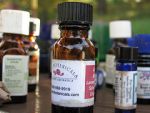Aromatherapy
Blending And Storing Essential Oils:

Essential oils are the basis for all traditional aromatherapy. Each one has a particular fragrance and properties and the art of blending them harmoniously combines the skill of the perfumer and the pharmacist. Although two essences may have a similar smell or property they may not necessarily mix well together. One essence can overpower the other. For example, frankincense and ginger, both heavy smelling essences, give an overpowering, unpleasant smell when combined, whereas lavender and rosemary happily marry together. In general it is best to use a maximum of three oils in a blend so there is less chance of detracting from their individual qualities.
The Art Of Blending:
Essential oils are highly volatile substances which should be handled, mixed and stored with care and used sparingly. Spillage of one particular oil can overpower a whole room and adversely affect young children and animals. The power of aromatics is quite subtle. Never try to sniff or smell a pure essential oil straight from the bottle. Place a drop on the side of a glass and become a connoisseur: sniff, consider and take notes if you wish.

Mixing:
Base oils play an important role in carrying and diluting highly concentrated essential oils, which are only used in small quantities measured in drops. These base oils dilute the pure essentials, inhibiting the evaporation rate and since they spread evenly and easily over skin, encouraging quick absorption of the therapeutic oils into the skin. When mixing, use a glass, porcelain or aluminum bottle and check that you have the correct amount of vegetable carrier oil before adding the recommended drops of essentials with a dropper or pipette for accurate measurements. Mix well and label the bottles clearly. If you accidentally spill any, wipe up instantly with a paper tissue and dispose of it outside as the smell will be overpowering. Dark glass bottles with stoppered caps are used to store essential oils. At home, keep them in a cool dark place, stand them upright, and always out of sight and touch of children. Never store essential oils in plastic bottles: both the oil and the bottle will perish. Oils will keep for at least a year if properly stored, although citrus oils may have a shorter life.
Carrier Oils:
Base oils are normally extracted from nuts or seeds and each has its own particular quality. Sweet almond oil is probably the best all-purpose carrier oil because it is neutral and non-allergenic. It can be used for massaging babies. Walnut acts as a co-ordinator and balances the nervous system: sesame is ideal for stretch marks: apricot kernel, peach kernel and evening primrose oils are all good for cell regeneration. Walnut and evening primrose oil help alleviate menstrual problems including pre-menstrual tension. Wheat germ acts as an anti-oxidant and will help preserve a mixture. These oils are all rich in nutrients, and are ideal for most dry and sensitive skin types. The most important thing when buying these basics is to check that they have been naturally processed and not chemically treated. Cold-pressed is best.
Note: Assemble bottles of different sizes for storing appropriate quantities of blended oils. Funnels and droppers ensure accurate measurements and help prevent spillages.
Aromatics:
Aromatic oils extracted from fruits, flowers, leaves, barks, resins and roots have been used throughout the centuries for their healing properties and marvellous fragrances. Hundreds of essential oils are used today in such industries as food, cosmetics, pharmaceuticals and perfumery. Modern day aromatherapy uses a much smaller selection, but the range of aromas and applications is nonetheless remarkable.